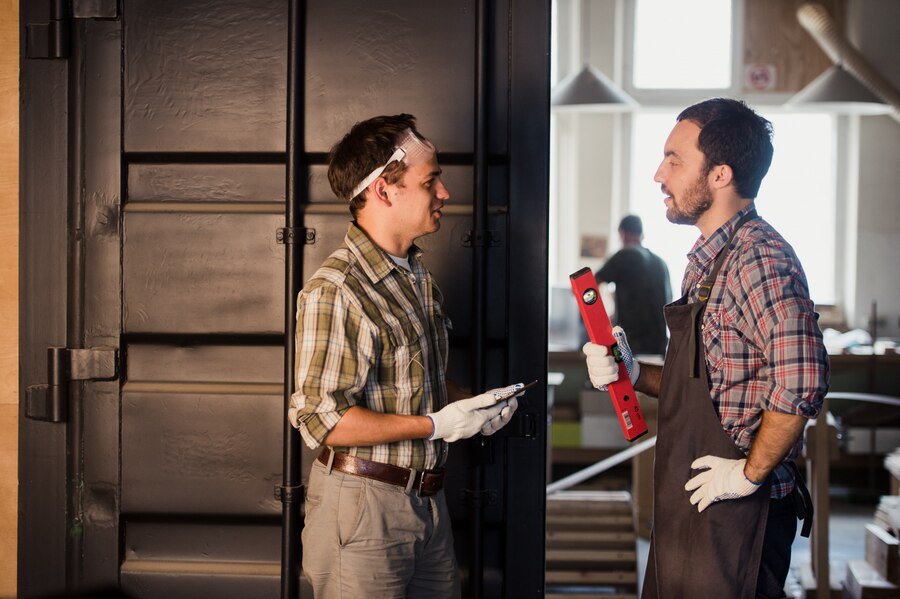Common Garage Door Issues And Quick Repair Tips
A properly functioning garage door is essential for the safety and convenience of homeowners. However, like any mechanical system, garage doors are susceptible to wear and tear, leading to common issues that can disrupt daily routines. From malfunctioning openers to noisy operations and uneven movements, these problems can cause frustration and inconvenience.
Fortunately, many garage door issues can be quickly addressed with simple repairs, saving time and money. In this blog post, we’ll explore some of the most common garage door issues and provide easy-to-follow repair tips to help homeowners restore functionality to their garage doors swiftly and efficiently.
Common Garage Door Issues
Garage door opener malfunctions, which can be caused by remote control or sensor faults, are a common problem; noisy operations due to worn-out components; uneven opening or closing caused by misaligned tracks or worn-out cables; stuck garage doors due to obstructions or lack of lubrication; and broken springs, which can lead to difficulty in opening or closing the door.
Malfunctioning Garage Door Opener
When your garage door opener fails to operate correctly, it can be due to remote control issues, sensor malfunctions, or motor problems. Remote control signals may not reach the opener, sensors might be misaligned or obstructed, or the motor may need repair or replacement.
- Remote Control Issues: If your garage door opener isn’t responding to the remote, check for signal interference, weak batteries, or a damaged remote. Reprogramming or replacing the remote may resolve the issue and restore communication between the opener and the remote.
- Sensor Problems: Garage door sensors play a crucial safety role. If the door reverses unexpectedly or won’t close due to sensor misalignment or dirt, realign the sensors, clean the lenses, and ensure no obstructions in the sensor’s line of sight.
- Motor Malfunctions: A malfunctioning motor can impede the garage door’s smooth operation. Inspect for loose wiring, overheating, or unusual noises. If identified, consult the opener’s manual for troubleshooting steps or consider professional assistance for motor repair or replacement.
Noisy Garage Door
A loud garage door may annoy you, often caused by worn-out rollers, hinges, or tracks. Proper lubrication of these components can significantly reduce the noise level. Additionally, regular inspection and maintenance can help identify and address sources of noise before they become more significant issues.
- Identifying the Source of the Noise: During garage door operation, attentive listening helps identify the root cause of the noise. Homeowners can precisely target their troubleshooting efforts by discerning whether the noise emanates from the rollers, hinges, or tracks, facilitating a more effective and efficient resolution of the issue.
- Lubrication Tips for Quieter Operation: Optimal lubrication of moving parts is essential for reducing garage door noise. Silicone or lithium-based lubricants, when applied sparingly, ensure smooth and quiet operation. By avoiding petroleum-based products, homeowners prevent the accumulation of debris that could exacerbate noise levels over time.
- Inspect Rollers, Hinges, and Tracks: Regular inspection of crucial components such as rollers, hinges, and tracks is vital for maintaining a quieter garage door. Checking for signs of wear, debris accumulation, and loose hardware enables homeowners to address potential noise sources promptly. Cleaning tracks, tightening hardware, and replacing damaged components contribute to quieter and more efficient garage door operation.
Uneven Opening or Closing
An improperly balanced garage door can lead to uneven opening or closing, posing safety risks and damaging the door mechanism. Misaligned tracks or worn-out cables are common culprits. Regular inspection and adjustment of these components help ensure smooth and balanced door operation.
- Checking for Misaligned Tracks: Misaligned tracks can cause uneven movement in your garage door. Inspect the tracks for gaps, bends, or obstructions. Use a level to ensure they are correctly aligned. Adjust or realign the tracks as needed to facilitate smooth door operation.
- Balancing the Garage Door: An unbalanced garage door can strain the opener and lead to uneven movement. Please open the door manually to check the balance halfway and release it. Adjust the tension springs or torsion system to achieve proper balance if it doesn’t remain in place.
- Replacing Worn-out Cables: Worn-out cables can compromise the safety and functionality of your garage door. Inspect cables for fraying, corrosion, or damage. If any issues are found, replace the cables promptly to prevent further damage and ensure smooth and even door opening and closing.
Stuck Garage Door
A garage door that gets stuck halfway can be frustrating and inconvenient. Obstructions in the tracks, damaged rollers, or lack of lubrication can cause this issue. Clearing obstructions, replacing damaged parts, and ensuring proper lubrication can often resolve the problem quickly.
- Examining the Tracks and Rollers for Obstructions: Obstructions in the tracks or debris on the rollers can result in a stuck garage door. Inspect the tracks and rollers for any obstacles or buildup and remove them for smooth door movement.
- Lubricating Moving Parts: Lack of lubrication can lead to friction and cause a garage door to get stuck. Apply lubricant to the rollers, hinges, and tracks to reduce friction and ensure smooth operation. Regular lubrication helps prevent sticking and prolongs the lifespan of the door components.
- Adjusting the Garage Door Opener Force Settings: If the garage door opener struggles to lift the door, adjusting the force settings may be necessary. Consult the opener’s manual to locate the force adjustment controls and adjust them accordingly to provide sufficient force for smooth door movement without straining the opener.
Broken Spring
Garage door springs bear the weight of the door and facilitate its movement. Over time, springs can weaken or break, leading to difficulty in opening or closing the door. Replacement of broken springs is crucial for safe and efficient garage door operation. Regular inspection and timely replacement can prevent sudden spring failures.
- Signs of a Broken Spring: Recognizing signs like difficulty opening the door, a visibly broken spring or a sagging garage door indicates a broken spring. Immediate action is necessary to prevent further damage and ensure safety.
- Professional Repair: Due to the high tension and potential danger involved, seeking professional assistance for broken spring repair is advisable. Trained technicians have the expertise and equipment to replace the broken spring safely, restoring the garage door’s functionality.
 Quick Repair Tips
Quick Repair Tips
Ensure you have essential tools like screwdrivers and wrenches for DIY repairs. Stock up on lubricants and replacement parts for efficient fixes. Follow step-by-step instructions for troubleshooting opener issues and reducing noise. Implement regular maintenance to prevent problems and consider professional services for comprehensive inspections.
Essential Tools for DIY Garage Door Repairs
Essential tools like screwdrivers, pliers, and wrenches are fundamental for addressing common garage door issues. Additionally, stocking up on lubricants, cleaning supplies, and replacement parts ensures you’re well-equipped to tackle various repairs efficiently, saving time and hassle.
Step-by-Step Repair Instructions
When faced with garage door problems, a systematic approach is critical. Start by troubleshooting opener issues, such as resetting remotes, adjusting sensors, or inspecting the motor. For noise reduction, identify the noise sources, lubricate moving parts like rollers and hinges, and tighten loose hardware to ensure smoother and quieter operation.
Checking and Replacing the Motor
If your garage door opener is malfunctioning, inspecting and replacing the motor may be necessary. Look for signs of damage or wear, such as unusual noises or overheating. Following manufacturer guidelines for motor replacement ensures proper installation and reliable garage door operation.
Prevention and Maintenance Tips
Ensure a smoothly functioning garage door by following these essential tips: Conduct regular inspections to catch issues early, lubricate moving parts to reduce wear and tear, tighten loose hardware for structural integrity, schedule professional maintenance annually, and replace weather stripping to maintain energy efficiency and weather protection.
- Regular Inspection Schedule: Implement a routine inspection schedule to identify potential issues early. Check for loose hardware, worn-out components, and signs of damage to prevent minor problems from escalating into significant repairs, ensuring your garage door operates smoothly and safely.
- Lubrication of Moving Parts: Regularly lubricate moving parts such as rollers, hinges, and tracks to reduce friction and wear. Use a high-quality silicone or lithium-based lubricant to guarantee efficient functioning and increase the lifespan of the parts in your garage door.
- Tightening Loose Hardware: Periodically inspect and tighten loose hardware, including bolts, nuts, and screws, to maintain the structural integrity of your garage door. Loose hardware can cause misalignment and contribute to premature wear, so ensuring everything is securely fastened is essential for optimal performance.
- Professional Garage Door Maintenance Services: Consider scheduling professional maintenance services at least once a year to ensure your garage door receives thorough inspections and adjustments. Professional technicians can identify potential issues early, perform necessary repairs, and optimize the performance and safety of your garage door system.
- Weather Stripping Replacement: Check and replace weather stripping to maintain a proper seal around your garage door. Damaged or worn weather stripping can allow drafts, moisture, and pests into your garage, compromising energy efficiency and potentially causing damage to your belongings. Regular replacement helps maintain a secure and comfortable garage environment.
Conclusion
In summary, ease of use, security, and comfort depend on a functional garage door. Homeowners can mitigate the risk of unexpected breakdowns and costly repairs by implementing regular preventive measures and proactive maintenance. Through routine inspections, lubrication of moving parts, and tightening of loose hardware, the structural integrity and efficiency of the garage door system can be preserved.
Additionally, scheduling professional maintenance services ensures thorough assessments and necessary adjustments are conducted to optimize performance. Furthermore, replacing weather stripping as needed helps maintain energy efficiency and protects the garage from adverse weather conditions. By following these preventive and maintenance tips, homeowners can prolong the lifespan of their garage door, minimize disruptions, and ensure a secure and functional entryway to their home.


 Quick Repair Tips
Quick Repair Tips